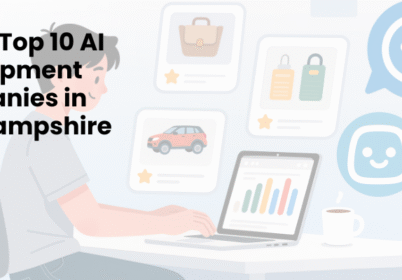Expert Guide: How to Use Figma AI to Transform Your Design Workflow

Table of Contents
Are you spending countless hours on repetitive design tasks, wishing for a smarter creative approach? Artificial intelligence has seamlessly integrated into one of the most beloved design platforms, transforming your daily workflow. Picture working on complex projects where intelligent assistance understands your creative intent and accelerates execution.
By the end of this guide, you will understand exactly how to leverage Figma AI to revolutionize your design process. This powerful integration helps you speed up workflows, automate tedious tasks, and generate creative assets more efficiently than traditional methods.
Figma AI represents a groundbreaking enhancement to the collaborative design platform you already know and love. This innovative technology merges human creativity with artificial intelligence to simplify UI and UX design, prototyping, and content creation.
Key Takeaways
- Readers will understand how Figma AI integrates artificial intelligence into design workflows to boost creativity, speed, and productivity.
Explore Figma AI’s core features—automatic layout generation, smart content creation, intelligent cleanup, and AI-powered prototyping. - Learn how to access and enable Figma AI tools through toolbars, plugins, and FigJam integration for different project types.
- Follow a clear step-by-step process to use AI prompts, refine outputs, and collaborate efficiently across teams.
- Discover how Figma AI enhances creativity, ensures design consistency, and accelerates project delivery while maintaining quality.
- Apply best practices to balance automation with creative judgment, ensuring human insight remains central to every design decision.
Table of Contents
What is Figma AI?
Have you wondered what happens when cutting-edge artificial intelligence meets your favorite design platform? Figma AI represents a revolutionary suite of AI-powered design tools that assist you in generating designs automatically. This intelligent system merges human creativity with machine intelligence to simplify your design process and workflows.
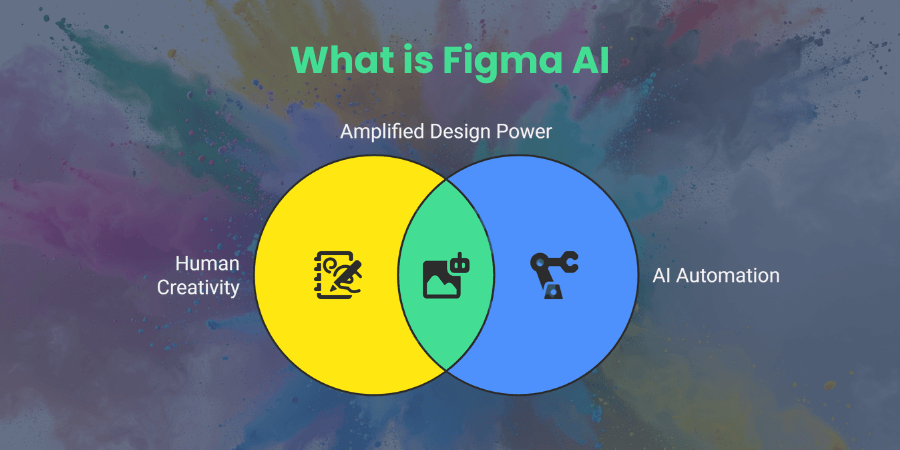
What makes Figma AI particularly exciting is how seamlessly it integrates into your existing Figma ecosystem. Rather than learning an entirely new platform, you enhance your current design process with intelligent automation. The technology is built specifically to enhance usability for designers, marketers, and product teams who want efficiency.
Picture yourself working on projects where you describe what you want in plain language. The AI helps bring that vision to life through intelligent suggestions and automations that feel intuitive. This is not science fiction anymore – it is your new creative reality.
When you use Figma AI, you are not replacing your creativity – you are amplifying it significantly. The technology serves as your intelligent design partner, handling routine tasks so you focus on strategic aspects. You maintain complete creative control while benefiting from machine learning that understands design patterns and principles.
Key Features of Figma AI
What specific capabilities does Figma AI bring to your design toolkit that will transform workflows? Let us explore the core AI-driven functionalities that make this technology genuinely useful for modern designers.
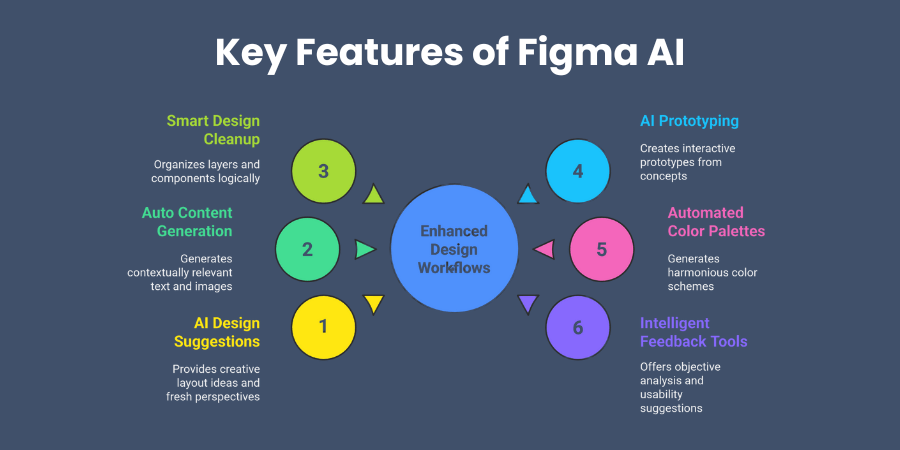
The AI-generated design suggestions and layout ideas feature acts like having an experienced design mentor nearby. When you are stuck on layout decisions or need fresh perspectives, the AI analyzes your work. You might find yourself surprised by creative directions you had not previously considered.
Auto content generation for both text and images represents another game-changing capability for your workflow. Instead of using placeholder text or searching for appropriate images, you generate contextually relevant content. This feature proves especially valuable when working on prototypes or demonstrating concepts with realistic content.
Smart design cleanup and component organization addresses one of the most tedious aspects of design work. Have you ever inherited a messy design file or found your work becoming disorganized? The AI can automatically organize layers, rename components logically, and maintain consistency across design systems.
AI-powered prototyping and wireframing capabilities help you move from concept to interactive prototype faster. You can describe the user flow you envision, and the AI helps create foundational structure. This allows you to focus on refining interactions and user experience details that matter most.
Automated color palette and theme creation takes the guesswork out of color selection completely. Whether starting new projects or refining existing designs, the AI generates harmonious color schemes. These palettes can match your brand guidelines or support your creative vision effectively.
Intelligent design summarization and feedback tools provide you with objective analysis of your work. The AI can identify potential usability issues, suggest improvements, and generate summaries that help communicate decisions. This capability proves invaluable when presenting design rationale to stakeholders and team members.
How to Access Figma AI
Wondering how you can start using these powerful AI features in your current Figma workspace? Accessing Figma AI is straightforward, though you will want to understand requirements and setup processes.
| Access Method | Plan Requirement | Location | Setup Time |
| AI Toolbar | Professional Plan | Main Interface | 2 minutes |
| Plugin Menu | Organization Plan | Plugins Section | 3 minutes |
| FigJam AI | Professional Plan | FigJam Interface | 1 minute |
| Beta Features | Early Access | Labs Section | 5 minutes |
Most Figma AI tools are included with Professional and Organization plans, making them accessible to serious designers. If you are currently on a free plan, you will need to upgrade to access features. The investment typically pays for itself quickly through improved productivity and enhanced creative capabilities.
To enable AI tools in your workspace, navigate to the toolbar where you will find new options. The plugin section also houses additional AI capabilities that you can activate as needed for projects. For FigJam users, AI features appear directly in the interface, making brainstorming and ideation more dynamic.
Beta features require joining the early access program through Figma Labs for cutting-edge capabilities. This gives you first access to experimental features, though you should expect some instability during testing.
How to Use Figma AI: Step-by-Step Guide
Ready to dive into practical aspects of leveraging Figma AI in your daily design workflow? Let us walk through a comprehensive, actionable process that will have you using AI capabilities confidently.
Open Figma or FigJam Project
Your AI journey begins with either starting a new design or opening existing projects for enhancement. When you create new files, you will notice AI-powered options appearing in various menus. For existing projects, the AI seamlessly integrates without disrupting your current work or file structure.
Consider starting with projects that have existing content, as this gives AI more context for suggestions. The system learns from your design patterns and preferences, becoming more helpful as it understands approaches.
Enable Figma AI Tools
Accessing the AI sidebar or plugin menu opens up intelligent design assistance throughout your workflow. You will find AI options integrated throughout the interface rather than confined to single locations. This thoughtful integration means you access AI help exactly when and where you need it.
The AI sidebar typically appears on the right side of your interface, offering contextual suggestions. Plugin menu options provide more specialized AI functions that you can activate for specific tasks.
Use Text Prompts
Here is where the magic happens – you enter natural language commands to generate design elements. Instead of manually creating every component, you tell the AI something like “create a modern login form.” The key to effective prompting lies in being specific while remaining natural in your language.
You do not need to learn technical commands or special syntax for effective communication. Describe your vision as you would to a human collaborator, and AI translates intent into reality.
Refine and Customize
Once the AI generates initial designs, you maintain complete creative control over refinement and customization. You can adjust layouts, modify fonts, tweak colors, and ensure everything aligns with brand identity. The AI provides the foundation, but your expertise shapes the final result for maximum impact.
This refinement phase often proves more efficient than starting from scratch completely. You build upon intelligent suggestions rather than facing blank canvases, allowing rapid iteration and experimentation.
Collaborate and Share
Real-time co-editing becomes even more powerful when combined with AI-assisted recommendations for team productivity. Your team members can see AI suggestions and contribute their own prompts, creating collaborative environments. The AI helps facilitate better collaboration by generating design summaries and maintaining organization standards.
Preview and Export
Finalizing and exporting AI-generated designs follows the same process you already know with added benefits. The system can recommend export settings, identify potential issues, and ensure designs translate well. You maintain complete control over final output while benefiting from intelligent recommendations that optimize results.
Benefits of Using Figma AI
What specific advantages will you experience when integrating Figma AI into your design workflow? Understanding these benefits helps you maximize the technology impact on productivity and creative output significantly.
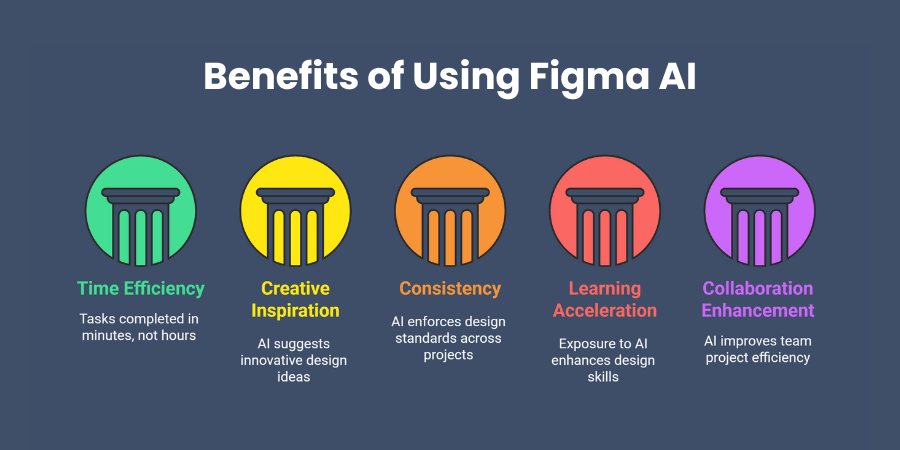
Time efficiency represents perhaps the most immediate benefit you will notice in your daily work. Tasks that previously required hours of manual work can now be completed in minutes effectively. Whether generating initial concepts, organizing messy files, or creating consistent design systems, AI acceleration works.
Creative inspiration flows more freely when you have an AI partner suggesting alternatives and possibilities. The technology exposes you to different design approaches, color combinations, and layout options that spark directions. This exposure can lead to breakthrough creative solutions you might not have discovered independently.
Consistency across your design projects becomes much easier to maintain when AI helps enforce standards. The system can identify inconsistencies, suggest corrections, and help you build more cohesive design systems. This consistency proves especially valuable for large projects or teams working on multiple related initiatives.
Learning acceleration occurs naturally as you work with AI suggestions and see different approaches. You absorb new techniques and best practices through exposure to AI-generated alternatives, expanding design knowledge. This continuous learning helps you grow as a designer while maintaining productivity and creative output.
Collaboration enhancement makes team projects more efficient and enjoyable for everyone involved in the process. AI-powered organization, naming conventions, and documentation help team members understand and contribute to projects more effectively.
Limitations of Figma AI
While Figma AI offers impressive capabilities, what realistic constraints should you expect when using AI? Understanding these limitations helps you set appropriate expectations and use the technology most effectively.
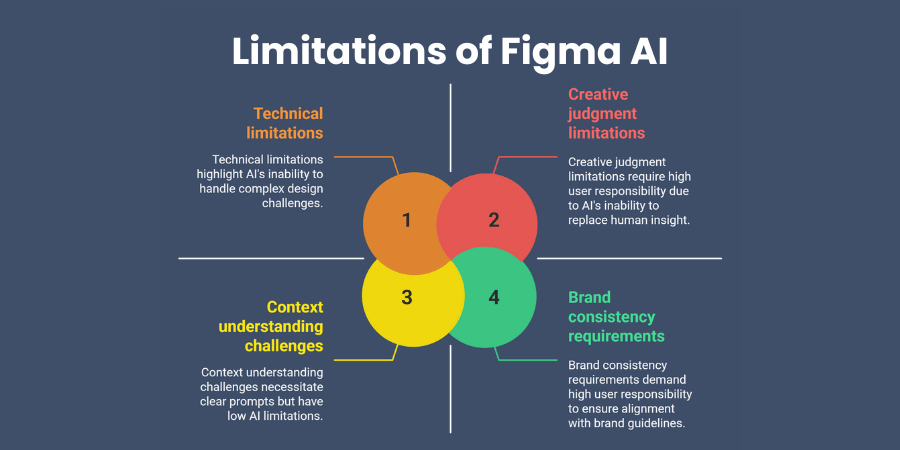
Creative judgment limitations mean that AI cannot replace your human insight regarding user needs and strategy. The technology excels at execution and suggestion but relies on your expertise for direction. Your understanding of brand personality and strategic design decisions remains crucial for project success.
Context understanding challenges can arise when AI misinterprets your intent or generates inappropriate suggestions. You need to provide clear, detailed prompts and be prepared to guide AI toward desired outcomes. This guidance requirement means you still need strong design fundamentals and communication skills.
Brand consistency requirements often need human oversight, as AI might not fully grasp subtle nuances. Industry-specific design conventions that are crucial to your projects require your expert knowledge. You remain responsible for ensuring all output aligns with brand guidelines and strategic objectives.
Technical limitations exist in terms of complexity and customization depth that AI can handle. While AI handles many tasks well, highly specialized or technically complex design challenges may require traditional approaches. Your expert intervention becomes necessary for sophisticated design problems that require nuanced understanding.
Dependency concerns arise if you rely too heavily on AI assistance without maintaining core skills. The technology should enhance your capabilities rather than replace your fundamental design knowledge and thinking.
Best Practices for Using Figma AI
How can you maximize output quality and efficiency when working with Figma AI tools effectively? These practical strategies will help you get the most value from your AI-enhanced design workflow.
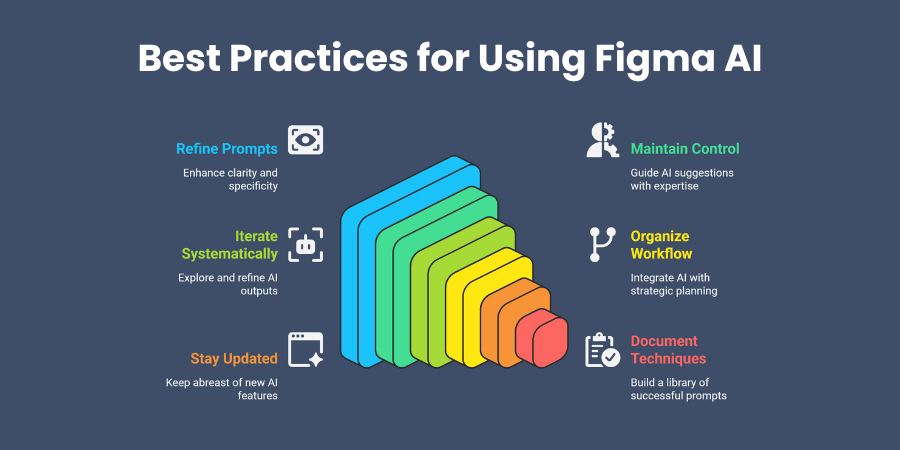
Start with clear, specific prompts that communicate your intent effectively to the AI system. Instead of vague requests like “make this better,” try detailed descriptions such as “create modern navigation.” The more context you provide, the better the AI can assist your creative process.
Maintain creative control by treating AI suggestions as starting points rather than final solutions always. Review every AI-generated element critically, ensuring it aligns with your project goals and brand requirements. Your expertise should guide all final decisions and creative direction for maximum project success.
Iterate and refine systematically rather than accepting the first AI suggestion that appears promising. Generate multiple options, combine elements from different suggestions, and use AI capabilities to explore variations. This systematic approach often leads to better final results than accepting initial outputs.
Organize your workflow to leverage AI strengths while compensating for its limitations through strategic planning. Use AI for rapid prototyping, content generation, and routine tasks that consume time unnecessarily. Rely on your human judgment for strategic decisions, user experience considerations, and overall creative direction.
Stay updated with new features and capabilities as Figma continues developing its AI offerings rapidly. The technology evolves quickly, and new features regularly become available that could enhance workflows. Staying current ensures you can take advantage of the latest improvements and capabilities.
Document your successful AI prompts and techniques to build a personal library of approaches. This documentation helps you work more efficiently over time and can be valuable for teams. Sharing effective techniques with colleagues can improve overall team productivity and creative output significantly.
Balance AI assistance with skill development by continuing to practice fundamental design skills regularly. Use AI to handle routine tasks while challenging yourself with complex creative problems requiring insight. This balance ensures you continue growing as a designer while leveraging AI capabilities effectively.
Conclusion
Figma AI is transforming the design landscape by blending automation with creativity in ways that empower you. This technology represents not a replacement for your creative skills, but rather powerful amplification. Your human creativity, strategic thinking, and understanding of user needs remain irreplaceable and valuable.
As you begin exploring and experimenting with Figma AI, remember that successful designers work alongside intelligence. Your creative vision combined with intelligent automation opens up endless possibilities for innovation and efficiency. Whether working on complex enterprise applications, crafting beautiful marketing materials, or prototyping breakthrough experiences, AI provides tools.
The future of design is here, and it is waiting for your unique creative touch. What will you create first with your new AI-powered design capabilities? Start experimenting today and discover how this technology can elevate your creative work to new heights.
Frequently Asked Questions
Do I need a special Figma plan to access AI features?
Yes, you need at least a Figma Professional plan to access most AI features effectively. Organization plans include additional AI capabilities for team collaboration and advanced functionality. Free plans have limited or no access to AI tools, so upgrading becomes necessary for leveraging these capabilities.
Can Figma AI replace human designers completely?
No, Figma AI cannot replace human designers in any meaningful way. The technology excels at automating repetitive tasks, generating initial concepts, and providing helpful suggestions. However, it lacks strategic thinking, user empathy, and creative judgment that human designers bring to projects successfully.
How accurate are AI-generated design suggestions?
AI-generated suggestions vary in accuracy depending on the complexity of your request and provided context. Simple tasks like color palette generation or basic layout suggestions tend to be quite accurate. Complex, brand-specific, or highly creative tasks may require significant refinement and human oversight for success.
Will using AI tools affect my design skills negatively?
Using AI tools will not hurt your design skills if you maintain a balanced approach. Focus on using AI for routine tasks while continuing to challenge yourself with complex problems. The key is treating AI as a tool that frees up time for higher-level thinking.
How do I get better results from Figma AI prompts?
Improve your AI results by writing clear, specific prompts that include relevant context about goals. Experiment with different prompt styles, iterate on suggestions rather than accepting first results immediately. Provide feedback to help the AI understand your preferences better over time for improved outcomes.
Shaif Azad
Related Post
Top 10 AI Development Companies in New Jersey for Business
Are you searching for the perfect AI development partner in New Jersey? Have you wondered which...
Top 10 AI Development Companies in New Hampshire
Are you watching New Hampshire’s tech landscape transform before your eyes? Your state is quietly becoming...
Top AI Companies in Nebraska Every Business Should Know
Are you a Nebraska business owner wondering how artificial intelligence could transform your operations? Picture this...


